Art World
Move Over, Function: Greek Designer Kostas Lambridis Arrives in New York With Wild New Works of Furniture Art
His Beetle-turned-bar, and other imaginative creations, are on view at Carpenters Workshop Gallery through November 23.
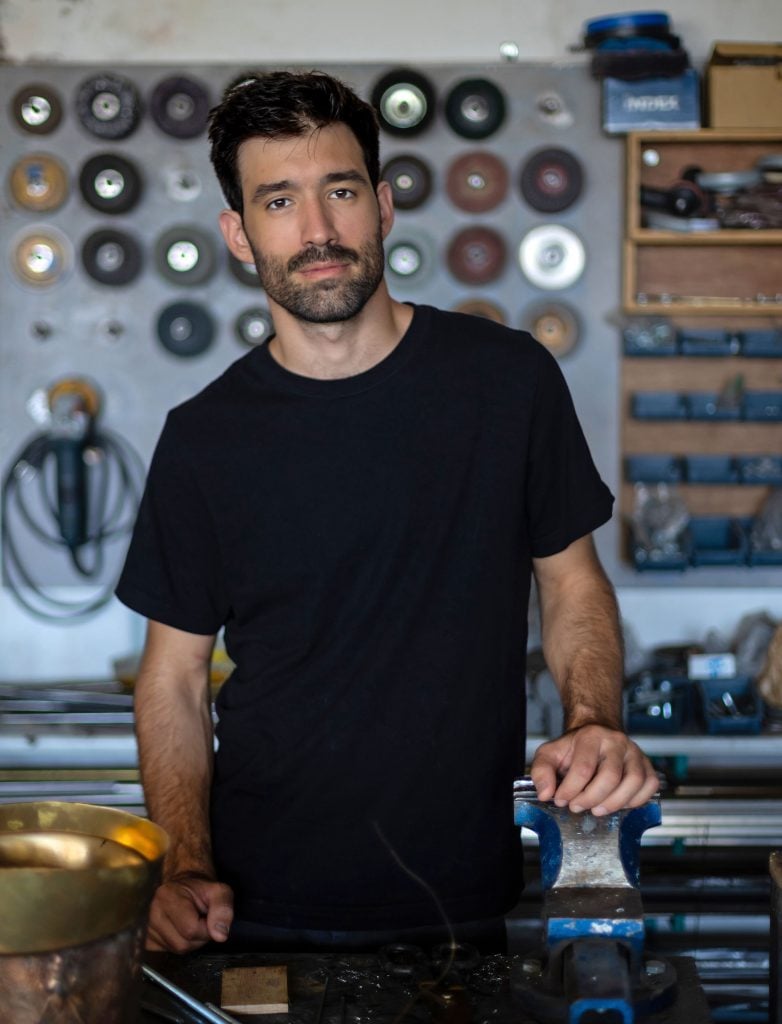
As if toiling in a mechanic’s garage, Kostas Lambridis emerged from under the fender of a Volkswagen Beetle to greet me, careful not to hit his head on its classic curvature. But he wasn’t going to tell me he’d fixed my car, nor was there a car to fix. Instead, the Greek designer was taking time out from installing new works at Carpenters Workshop Gallery in New York—“Reverse Fireworks in Slow Motion” (through November 23)—to explain how these wildly fantastical pieces came to exist.
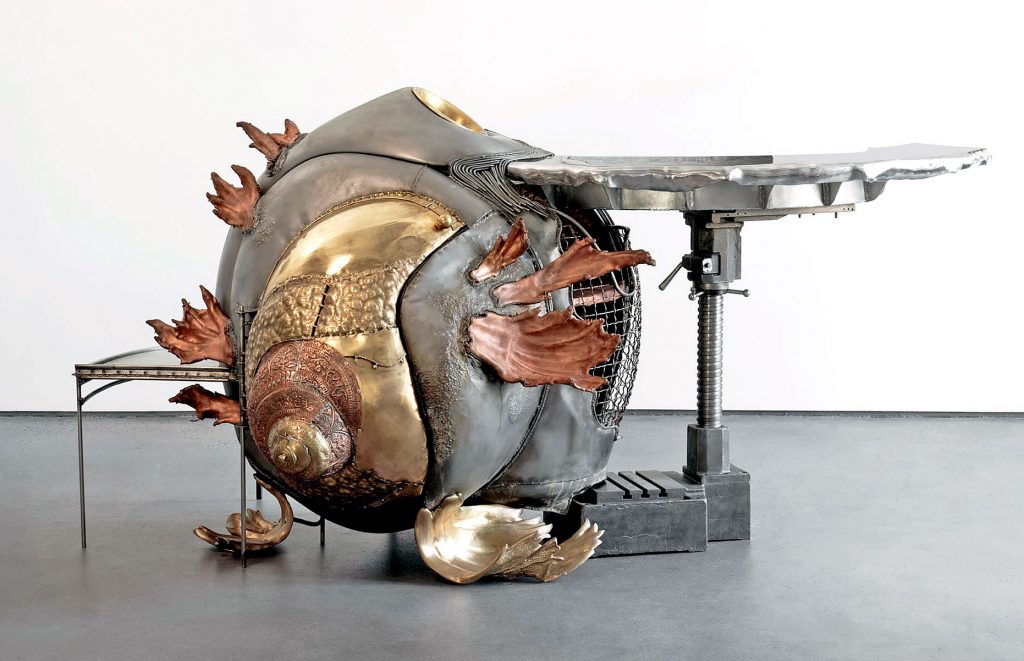
Kostas Lambidis, aerial shell bar. Photo: Matt Harrington. Courtesy of Carpenters Workshop Gallery.
Starting with how this car became a bar. It’s a striking piece that was forged, said Lambridis, from a multitude of sources. He cobbled together the steel fender from a friend’s broken-down Beetle with a door from a Citroën that he’d scavenged from scrap yards around Athens. He then welded on an iron drill base, a polished aluminum bar top, and bits of copper from “flea markets where I go every Sunday.” He likened the result, a hulking mass of metal, to an “ancient Roman chariot, but steampunk.”
The comparison to Les Lalanne’s endearing animal bronzes—their bestiaire—is inevitable, though the young designer doesn’t mind analogies; it’s how he started. In a 2017 group show sponsored by Fondation Cartier in Paris, he reimagined some of the world’s most iconic furniture designs. In one of them, he paid homage to the Badminton Cabinet, a marvel of ebony and pietra dura commissioned in 1726 and said to have taken 30 expert Florentine craftsmen six years to make.
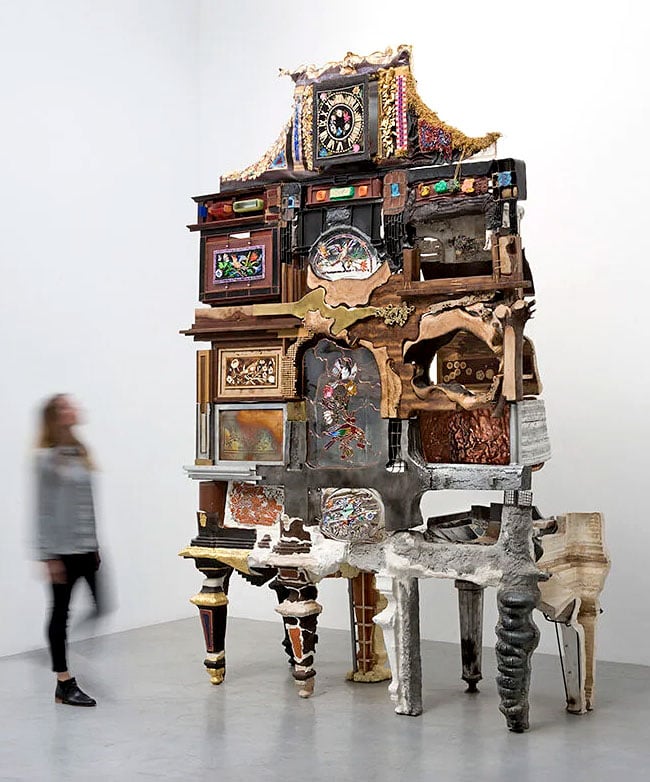
Kostas Lambridis, Elemental Cabinet. Photo: Matt Harrington. Courtesy of Carpenters Workshop Gallery.
The ornate cabinet was auctioned at Christie’s in 2004 for $36 million, making it the most expensive item of furniture ever sold—and an enduring source of fascination for Lambridis. His contemporary take on the masterpiece—part of his master’s degree (in contextual design) at the Design Academy of Eindhoven in the Netherlands—incorporated no ebony or pietra dura, but humbler materials. Concrete and stone formed the base, with wood and plastic appearing further up. The cabinet’s famous clock at the top was refashioned using found textiles and electronic parts.
But in his new show at Carpenters Workshop—his first solo exhibition in the U.S.—Lambridis has done away with hierarchy, working instead in what he calls a mono-material approach. He treats four materials—metal, wood, mineral (stone), and plastic—equally. “When you look at my previous work, there is a certain level of complexity,” he explained. “But I realized that by focusing on just one material, I can find the same level of complexity within it.”
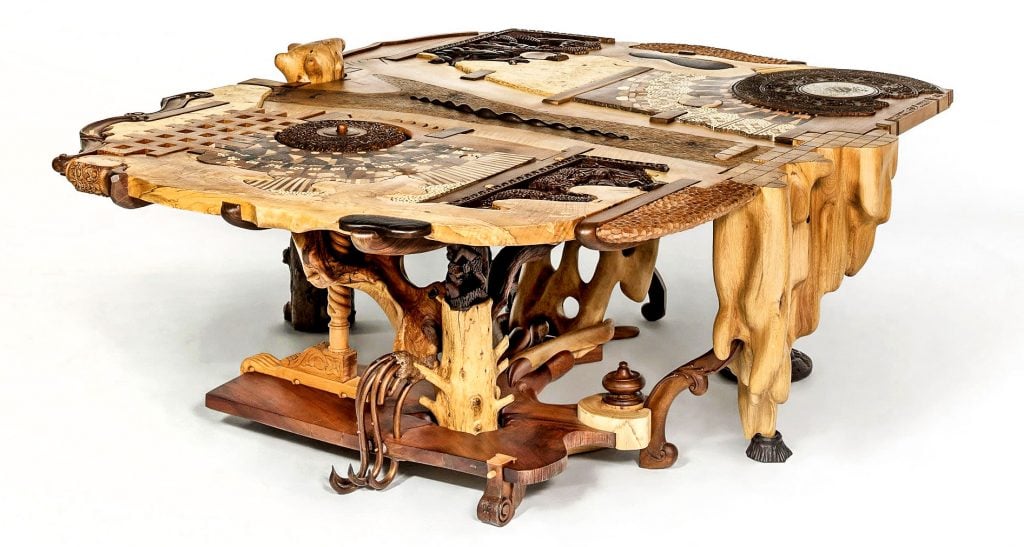
Kostas Lambridis, fused before charred dining table. Photo: Matt Harrington. Courtesy of Carpenters Workshop Gallery.
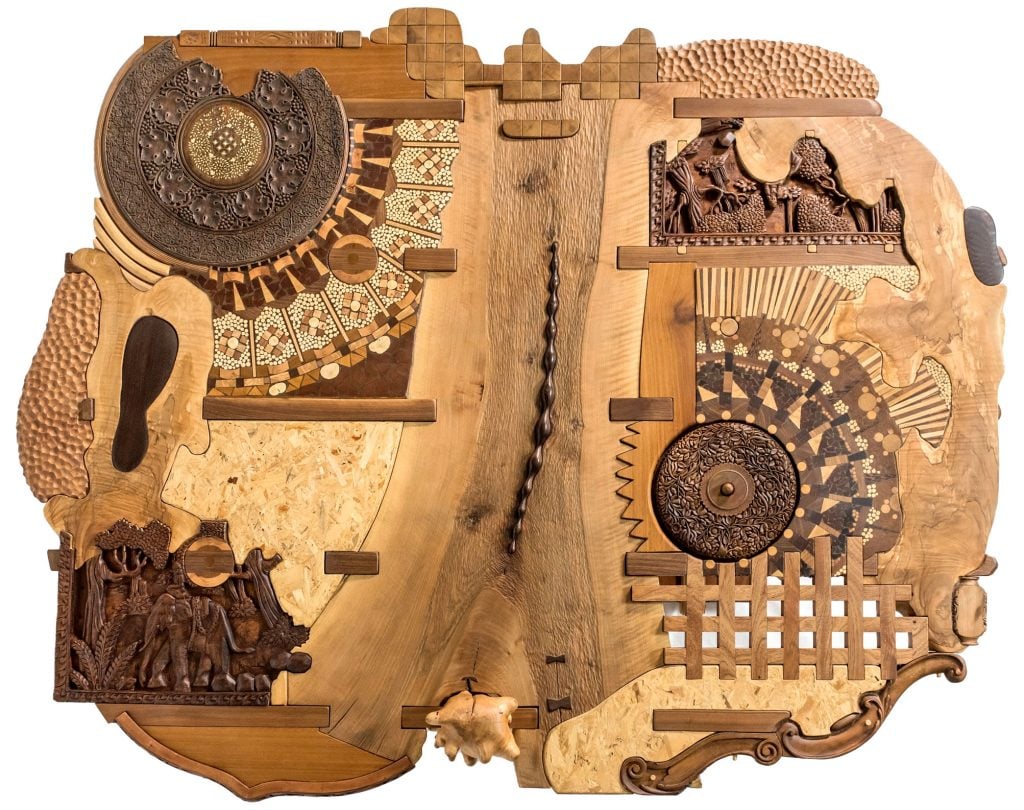
Kostas Lambridis, fused before charred dining table. Photo: Matt Harrington. Courtesy of Carpenters Workshop Gallery.
“Like this wood table,” he said, pointing to a sinuously carved stunner in the center of the gallery. “I only knew two things when I started making it, that it would be a dining table and it would be made of wood—nothing but wood.” He fused various pieces—ranging from African iroko and Greek olive to American walnut and Portuguese cypress—with ready-made wood carvings he’d already collected to create the patchwork effect. One elephant figurine (lower left) was likely a souvenir when it was made, possibly in Southeast Asia—“a memory of a trip to an exotic place, something that was new at the time but has lost value over time,” he presumed. “Then it came into my hands.”
Lambridis works by letting the unfinished item speak to him, guide him. There are no plans or blueprints. “A fascination with materials is what drives me,” he said. “When I start a piece and it begins to unfold, I listen to it. When it becomes too much of one thing, we push the other way. When I feel it’s becoming too straight, I add some curves. Or when I feel it looks too expensive, I’ll add cheap materials. I don’t claim to be making anything new; nothing is new.”
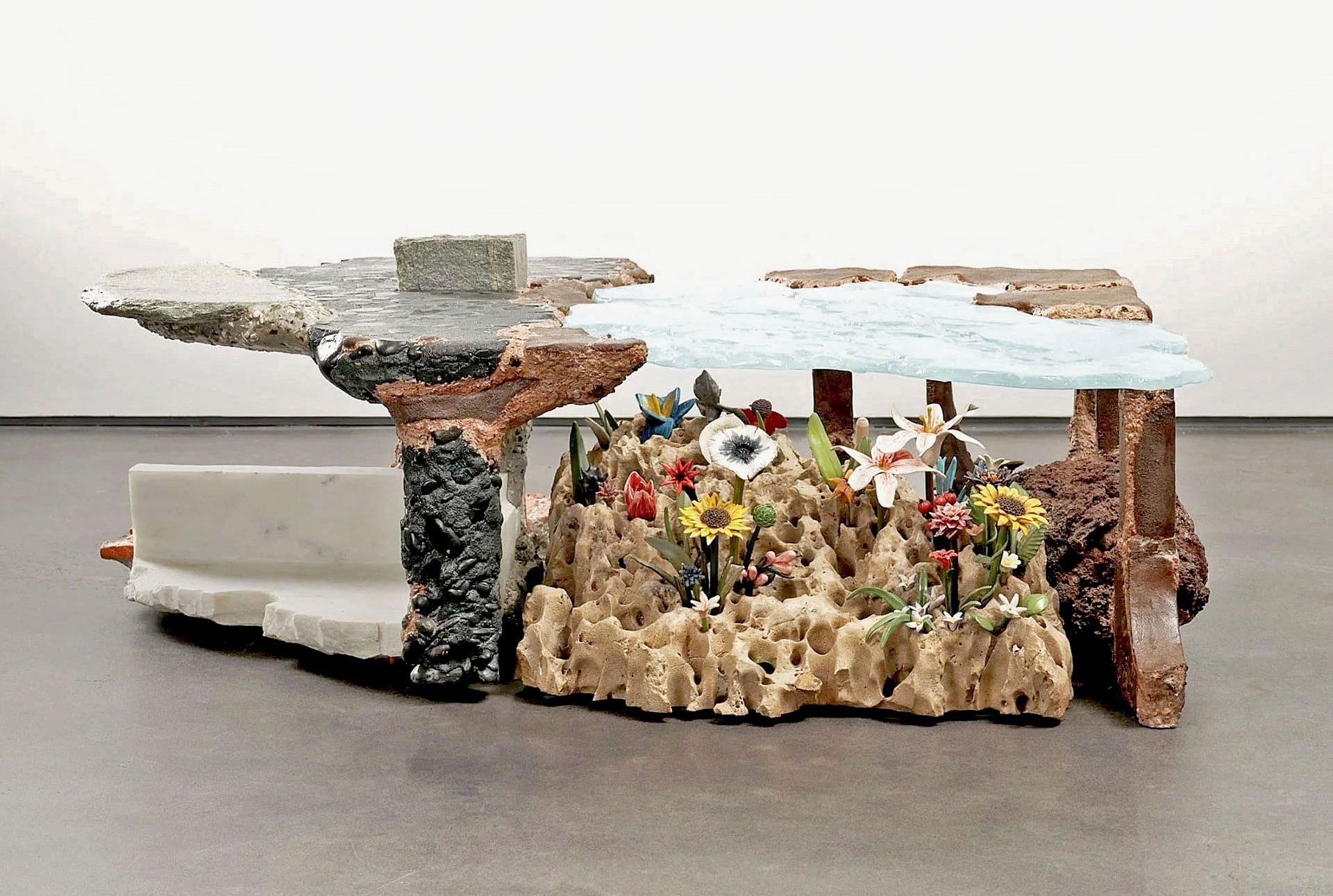
Kostas Lambridis, all you need now is some oxygen table. Photo: Matt Harrington. Courtesy of Carpenters Workshop Gallery.
His studio in Athens is itself a kind of art project, filled with broken ceramics and glass, bits of rattan and bamboo baskets, discarded tiles, and plastic lawn chairs. His team “keeps their eyes open” and when they see something on the street, they’ll send a picture on WhatsApp to Lambridis, who’ll retrieve it, even if “it might be years before it finds a way into a work.” Chaos, however, does not reign in the workshop. Rather, its four corners correspond to the four materials he’s working with. “We are very organized,” he smiled.
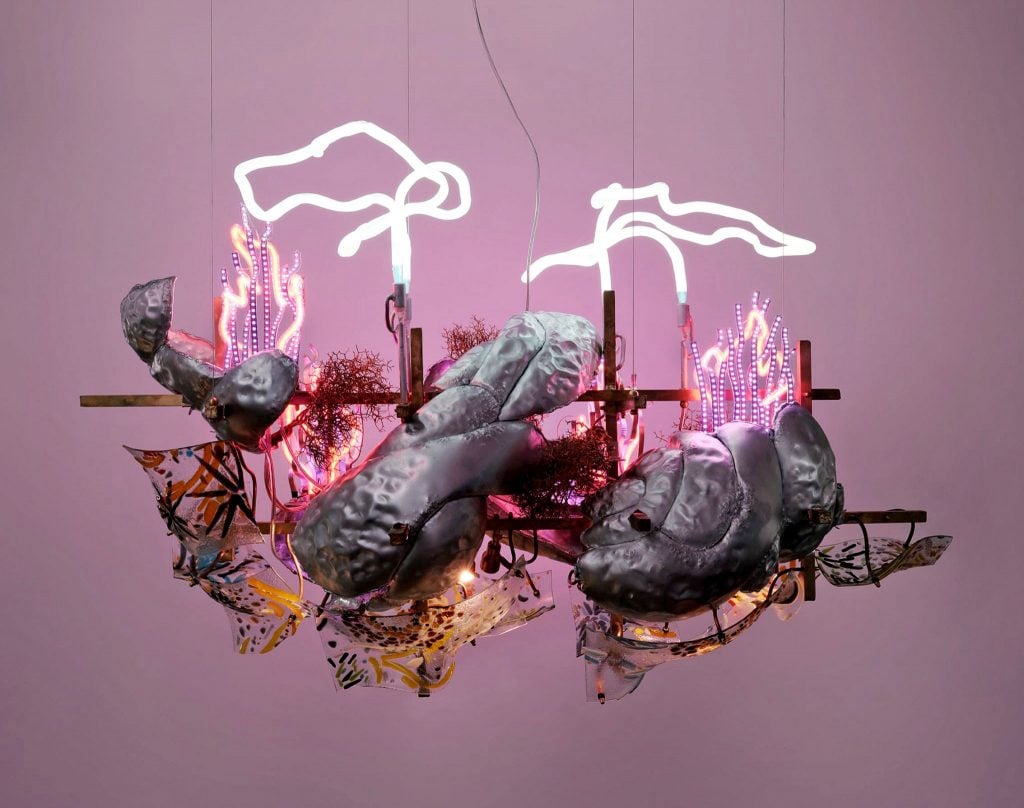
Kostas Lambridis, spin, rise, and thrust in random direction chandelier. Photo: Matt Harrington. Courtesy of Carpenters Workshop Gallery.
Take, for instance, the light sculpture referenced in the show’s title, “Reverse Fireworks in Slow Motion.” He imagined the chandelier as a firework that has been freeze-framed in the act of exploding. He’s most happy with this piece as it is emblematic of both the show and his practice. “It’s a metaphor for how I work,” he said. “I collect all these random things and make them into one. Ideas, thoughts, references—it’s like they all come together in this one spark.”





